Me and Joe did not stay long in Cortes, Surigao del Sur. It was just an overnight stay, a short visit to a shipmate and his family. The next day we prepared early because it will be a long drive back to where we came from. We wanted to find what ports were there in the five towns we just whizzed by the previous day. Me and Joe also planned to shipspot Taganito again and see if there are accessible ports there. We intended a make-up since the previous day all my batteries gave up while we were there and we were a little rushed up already lest nightfall overtakes us while we were still on the road.
Joe again mounted his a-little-balky GPS map as we will use it again in searching for ports (I realized already then that my plain refusal to use the capabilities of my smartphone is already a negative as I can’t assist Joe). We passed by Lanuza, Carmen and Madrid towns without any signs of a port. It was actually Madrid which interested as more as the owner of the “Voyagers” restaurant which we patronized on the way to Surigao del Sur hailed from that town and the shipmate of Joe was familiar with the surname (he said one of the most prominent families of that town).
We knew there will be a port that we will be visiting in the next town of Cantilan because the previous day we already saw its sign by the highway. Cantilan sticks to my mind because the controversial Prospero Pichay hails from that town and he claimed it was the mother town of that area and I was looking for signs of that. A presence of a port I will not be surprised because that is one of the givens at times if a powerful congressman hails from the place.
We found the road sign alright and it was indicated there the distance is 6 kilometers. Not near, we thought, but we were determined to see what it has because we wanted to see what Prospero Pichay has given his place. We were lucky that the road is already cemented in many places and those not were not muddy. We noticed signs of a fiefdom and we just continued on as the seaview is good. We found the Port of Cantilan which is in Barangay Consuelo.
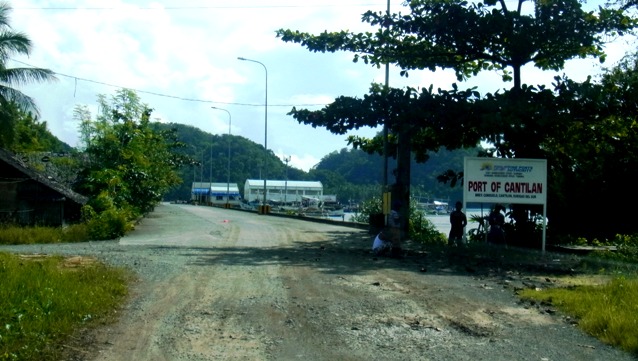
It was not a disappointing visit. The view was good with islets near the port and there were vessels but almost all were fishing vessels of the basnig type. I was surprised that one of those was the Clemiluza which I used to see in Cebu before. There were two fish carriers in the port and the total number of basnigs was nearly 10. The port had concrete buildings. I don’t know but the impression I got of the Port of Cantilan was that of a fishport.
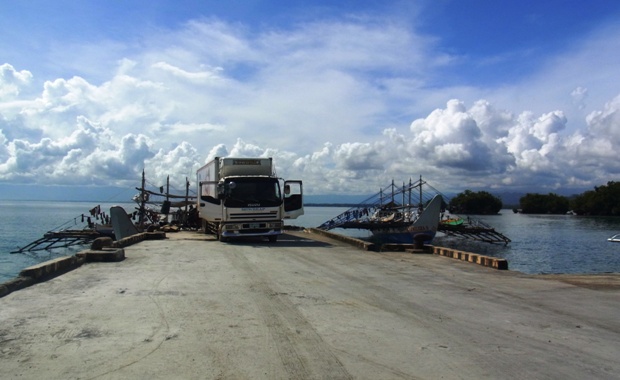
In the next town of Carrascal, the last town of Surigao del Sur going north, there were views of the sea and mines and it was a warning to us that Taganito is not too far anymore. Me and Joe tried a small road that goes to the sea. There was no port. What is noticed is the water by the beach. It is not the normal blue. It is brownish with some relation to muck including the smell. I wondered if there was fish still to be caught there.
We then reached the part which I remembered will show us the mining communities below which is part of the boundary of the two Surigao provinces. There was really no good vegetation and the terrain seemed to be really harsh before. I can sense there was really no good serviceable road here before the mines came. I remembered what the shipmate of Joe said to us the previous night that at his age he has not been yet to Butuan City or Surigao City because he said there was no road then. He said that if they needed something that is not available in Tandag, their capital and next town, they go to Davao (he studied college in Davao City by the way). Now I understand why before the Caraga Region was established, Surigao del Sur was part of Region XI that included the Davao provinces.
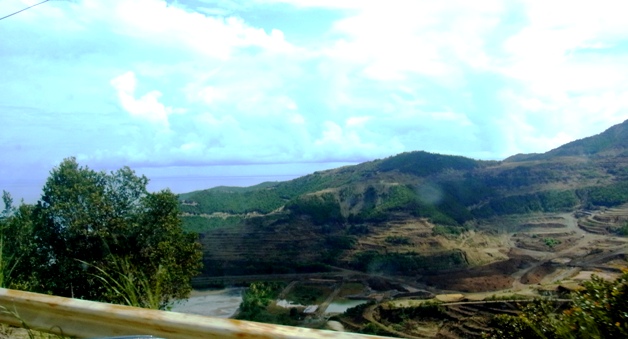
We descended and reached sea level which is an indication the mining community centered in Taganito is already upon us. The bulk of the harsh and mountainous terrain is already behind us. It was the actually the physical boundary of Surigao del Norte and Surigao del Norte (and it confirmed to me what I noticed before that the actual boundaries of the provinces of Mindanao are actually physical boundaries too).
We knew from the day before that there was an indication of an open port in the area and we found it. It is the Port of Hayanggabon, a PPA (Philippine Ports Authority) port and it is still being constructed but it is already usable. It is obvious it is meant to be a RORO port. To where, I can surmise that it would an alternative port for the islands of Surigao del Norte. Bucas Grande island, the third major island off the Surigao coast with the town of Socorro is just offshore and Claver can be its link to the mainland. The Port of Hayanggabon can also be the dock of ships with supplies from Cebu and Manila.
We took photos of the ships in Hayanggabon port and also the vessels offshore (this is one of the characteristics of the Taganito area, the presence of a lot of ships offshore). We roamed the general area. There is a barangay hall that can pass off as a municipal hall in some remote areas of the country. There are also restaurants that is already more modern-looking than the usual roadside stand. One thing noticeable is a lot of mining trucks that were on the move aside from other mining vehicles.
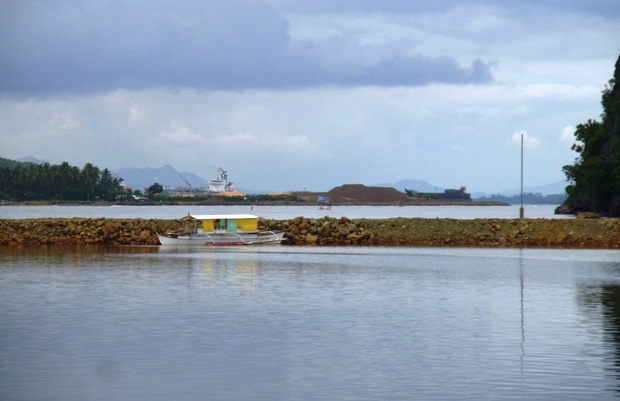
With the developments we saw, it seems the mining companies are doing CSR (Corporate Social Responsibility) work. It can be seen in the schools, the school buses, the ambulance and the community lighting. Well, they should. They are earning a lot of money after all. Strip mining near the shore with no tailings ponds with just causeway ports means lower initial capital, lower operational costs over-all and hence more profits.
We did not try entering a mining port. We are almost sure they won’t allow us (they can easily cite the risks and company policy). We contented ourselves with shots from the road. However, I realized that with a vehicle and enough time one can look for vantage places but one needs really long lenses for Taganito as half of the ships are offshore. My 10x zoom was just barely capable for the ships that are docked.
We also took photos of the mining yards, the motor pools, the cuts in the mountain (the strip mines) and almost any other thing connected to their activities that are visible outside. It is seldom that one is near a mining community after all with its activities visible and palpable. Even their equipment is interesting enough. There is even a conveyor belt overhead. But I just wonder with all the heavy loads how long will the road hold before cracking.
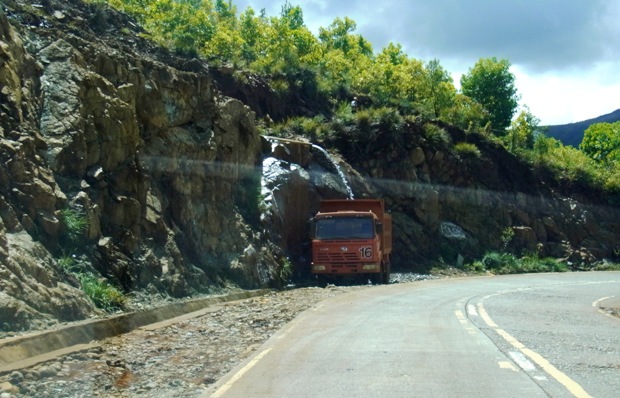
From Claver we sped up already. No more looking for ports and we intended to bypass Surigao City and head direct to Lipata Ferry Terminal. We knew it will be a really late lunch after all the sightseeing and shipspotting. Our target was “Voyagers” restaurant again. We loved the sights, the ambience, the newness and cleanliness plus I can recharge batteries there again, a crucial need in any long-distance shipspotting.
Before going to “Voyagers” we went first to the Lipata Ferry Terminal to know what were our ferry options and to arrange our ride. Of course when one goes canvassing we become an attractive target for the shipping company employees and their runners. There will of course be all the offers and blandishments plus the lies. I was used to that. I actually tried to be the front man instead of Joe because I know I can exude the mien of a veteran.
Actually, our first preference was the FastCat M7 so we can experience a good, new catamaran RORO on that route. Besides our preferred docking port is Liloan as we have been in Benit already on the way to Surigao (so taking a Montenegro Lines ferry again is already out of the options). We also want to shipspot that port from the inside.
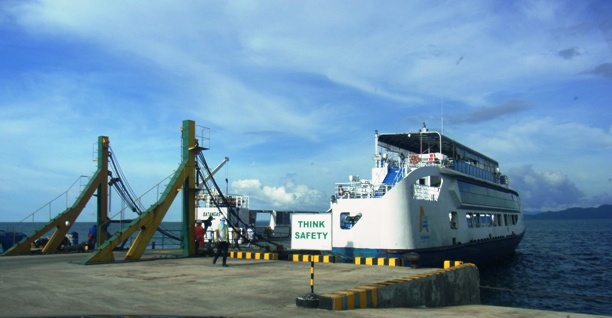
The first ferry leaving for Liloan was the Millennium Uno of Millennium Shipping, an old and slow ferry. They lied about a 3-hour running time and said it will arrive in Liloan ahead of the FastCat M7, two obvious lies. Whatever, it will be the FastCat M7 for us. We do not want an old, slow and uncomfortable ferry that has no airconditioning. Joe after a continuous trip from Catarman to Tacloban, back to Catarman then back again to Tacloban and then Surigao del Sur needed an accommodation more than a basic one.
And so it has to be FastCat M7, our original choice. However, it will still be more than two hours from departure. Oh, well, we decided we will just while our time in “Voyagers” and charge my batteries. The Archipelago Ferries man did all the paperworks and we appreciated that (uhm, what a nice rolling cargo service, we thought). He returned with the change and I asked what was paid for. We learned that included already in the total charges was a “Barangay Fee” of 50 pesos.
Me and Joe had a hearty laugh with that. They were able to put one over us. We just explained to the Archipelago guy it is illegal per two Supreme Court final decisions. We let it at that. Me and Joe just wanted to fill in our stomachs, have some rest and enjoy the coziness of “Voyagers”. We already deserve it after over 1,100 kilometers of travel and 3 sea crossings over 4 days (Joe already had 1,400 kilometers over 5 days) and we still have 1 sea crossing and 400 kilometers to go).
We again went to “Voyagers” and they were surprised we were back. We told them they are the best around in Lipata and we like the ambience. Maybe because of that they gave us free halaya. It was delicious. We ordered one as baon but it turned out it was not for sale. “Voyagers” is one restaurant we can really recommend. Very hospitable. It like its settee that is like a sala plus its elevated location which is airy and nice for looking around.

After two hours of rest we began the embarkation process. It was smooth. FastCat was more professional. I had small talk with some of the hands on the deck. That is where I learned that the Philtranco buses are no longer loaded (one of the reasons for the slack in rolling cargo). It is just the passengers and cargo of the bus and the process is the same in Liloan so in effect the passengers from opposite directions just swap buses. Looks neat but they said the passengers don’t like it.
The FastCat M7 is nice and relaxing. The passenger service and the canteen are good along with the rest of the ship which is new. Our trip is two-and-a-half hours and I was glad it was longer than the Lipata-Benit route as Joe can have more rest. I didn’t have much rest because as usual I was just milling around the ship until it got too dark for taking shots. Before that Benit port was visible and we had a freighter as a companion. By the way, we overtook Millennium Uno just after the midway of the route even though it departed an hour ahead of us.
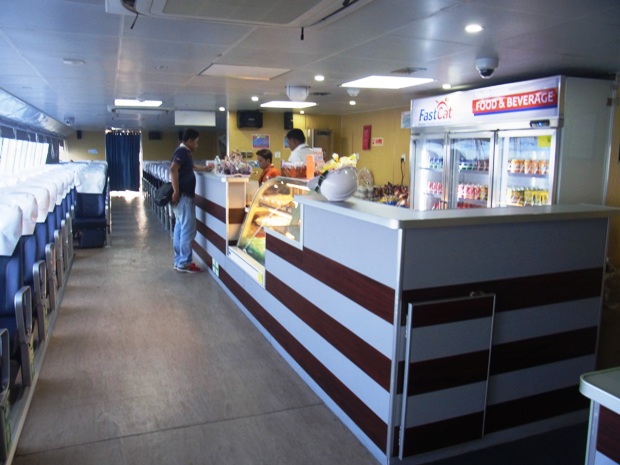
It was dark when we disembarked in Liloan Ferry Terminal. Joe parked the car first because I was making a round of the port taking shots and taking stock. There are more controls now but I was still able to get around. It did not change much anyway. However, because of the dark my shots were limited.
We then proceeded and not long after Joe asked where we can eat. I told him the nearest town with decent eateries is Sogod, the biggest town in the area. So instead of proceeding direct to Mahaplag we turned west in Sogod junction to the town. Nearing the town I was puzzled that past dinnertime there were still a lot of vehicles on the road and there was more near the town and inside the town there was traffic. Turned out it was the fiesta of the town but unfortunately we knew no one there. Sayang. We saw the barbecue plaza of the town and we had dinner there. It was satisfying.
After that was the drive again by the river of Sogod. Each and every time I pass it there seems to be changes because there is erosion andthe river change. We then turned to the left in Sogod junction and I warned Joe that from there it will be all uphill. The rain began coming. I don’t know but I associate that place with rain. Maybe it is because the vegatation is still heavy with a lot of trees and it is watershed area.
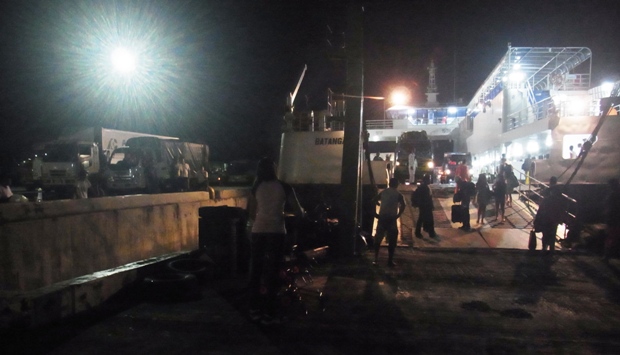
Me and Joe will be running through Mahaplag again because the puppy we were supposed to pick up in Isabel was not available. Sayang. We could have stayed the night in Sogod, had more fun there and ran the picturesque seaside road to Maasin the next day and visit the many ports of Southern Leyte and western Leyte up to even Palompon. It would have been a hell of a shipspotting day.
We reached Mahaplag junction again and it was another disappointment as it was already night and there were no hawkers of kakanin and suman anymore. Me and Joe really wanted to test the rumored “poisoners” of the area, a thing we both laugh at because we knew it is not true. Never had a stomach ache in almost two decades I bought from that place and I am still alive.
Heavy rains pelted us after Mahaplag all the way to Tacloban. Joe was already showing signs of tiredness and the weather was not cooperative. In some sections there were already inches of water on the highway demanding more attention from a tired driver. We finally reached Tacloban near midnight.
We were unlucky because the hotels we went to were all full. Maybe because of the hour? We were wondering. We thought Tacloban was disaster area. We then found one across the Sto. Nino Shrine. It was not cheap but the accommodation was good. We have to settle for it. Joe was already clearly tired. Who would not be after 1,300 kilometers on the road spread over 5 consecutive days?
We retired immediately for the next day we will be looking for the unexplored old ports of Samar. Our main targets were Basey and Victoria ports. Guiuan we deemed was too far already.
[That part I already wrote in a previous article:,,,,]


